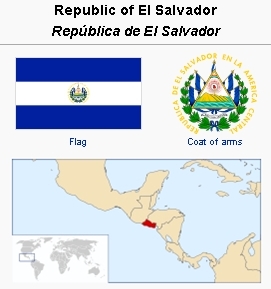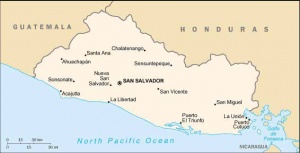Difference between revisions of "El Salvador"
| [checked revision] | [checked revision] |
m (Added category.) |
m (Wikified table.) |
||
| Line 1: | Line 1: | ||
__FORCETOC__ | __FORCETOC__ | ||
__TOC__ | __TOC__ | ||
| − | + | [[File:ElSalvador.jpg|300px|thumb|left|''El Salvador. World Factbook, 2005 '']] | |
| + | [[File:El%20Salvador1.jpg|271px|thumb|right|''Source: [http://en.wikipedia.org/wiki/Image:LocationElSalvador.svg Wikipedia Commons]'']] | ||
| + | = Introduction = | ||
| + | El Salvador is located in [[Central America|Central America]], bordering the Pacific Ocean between [[Guatemala|Guatemala]] and [[Honduras|Honduras]]. It lies on the Gulf of Fonseca, as do Honduras and Nicaragua further south. The capital city of San Salvador is the largest city of the republic. | ||
El Salvador is the smallest and also the most densely populated country in Central America. The total area of El Salvador is 21,040 km<sup>2</sup> (8,124 square miles) and in July 2010 the population was estimated to be 6,052,064. The population is 85% Mestizo, 12% White/Caucasian, and 1% Amerindian (Pipil, Lenca). | El Salvador is the smallest and also the most densely populated country in Central America. The total area of El Salvador is 21,040 km<sup>2</sup> (8,124 square miles) and in July 2010 the population was estimated to be 6,052,064. The population is 85% Mestizo, 12% White/Caucasian, and 1% Amerindian (Pipil, Lenca). | ||
According to a survey in 2008, 52.6% of El Salvador's residents are [[Roman Catholic Church|Roman Catholic]] and 27.9% are Protestant. | According to a survey in 2008, 52.6% of El Salvador's residents are [[Roman Catholic Church|Roman Catholic]] and 27.9% are Protestant. | ||
| − | + | = 1990 Article = | |
| − | + | Three Mennonite groups were active in El Salvador in 1986: the [[Iglesia Evangélica Menonita, El Salvador |Iglesia Evangélica Menonita]] ([[Beachy Amish Mennonite Fellowship|Beachy Amish]]), the [[Iglesia Evangélica Menonita de El Salvador|Iglesia Menonita de El Salvador]] (Metapán), and [[Mennonite Central Committee (International)|Mennonite Central Committee]] (MCC). The Iglesia Evangélica Menonita was begun in 1968 following six years of social service work in cooperation with the government. Seventy-five members meet in six locations in central and western El Salvador. In addition, the churches supported a variety of social service projects including an [[Orphanage Society of the Eastern District Conference|orphanage]], day schools, and refugee programs. The Iglesia Menonita del El Salvador (Metapán) is related to the [[Iglesia Evangélica Menonita Hondureña|Iglesia Evangélica Menonita of Honduras]] (Honduran Mennonite Church) begun by [[Eastern Mennonite Missions (Lancaster Mennonite Conference)|Eastern Mennonite Board of Missions and Charities]] workers. The congregation in Metapán began when Salvadorans living in [[Honduras|Honduras]] were repatriated after the 1969 war between the two countries. The church has grown from a few members to more than 100 and erected a building in 1982. Now it is planting churches in nearby communities. | |
[[Mennonite Central Committee (International)|Mennonite Central Committee]] began its work in El Salvador early in 1981 in response to the tremendous refugee needs that were a result of the civil war which began the previous year. MCC supported the work of local churches that had already started assistance programs in several, primarily rural, areas of the country. The emphasis was on emergency assistance including housing, clothing, medical care, and food distributions. This aid was continuing in 1986 but it had become a lower priority. As some of the local churches began to recognize the long-term nature of the war, they began to see ways to address the root causes of the conflict in addition to providing emergency assistance. Over the years, MCC has cooperated with them in resettlement projects, advocacy of dialogue and negotiation, and attempts to provide aid to the most affected rural areas so that residents would not have to become refugees and further strain the services of the larger towns and cities. Increasing emphasis has been placed on education of North Americans in the hope that the United States policy based primarily on a military solution can be changed to one of encouragement of a negotiated solution. Another emphasis is to accompany the Salvadoran churches as they face persecution while ministering to the poor and seeking to be peacemakers. -- <em>Ron Flickinger</em> | [[Mennonite Central Committee (International)|Mennonite Central Committee]] began its work in El Salvador early in 1981 in response to the tremendous refugee needs that were a result of the civil war which began the previous year. MCC supported the work of local churches that had already started assistance programs in several, primarily rural, areas of the country. The emphasis was on emergency assistance including housing, clothing, medical care, and food distributions. This aid was continuing in 1986 but it had become a lower priority. As some of the local churches began to recognize the long-term nature of the war, they began to see ways to address the root causes of the conflict in addition to providing emergency assistance. Over the years, MCC has cooperated with them in resettlement projects, advocacy of dialogue and negotiation, and attempts to provide aid to the most affected rural areas so that residents would not have to become refugees and further strain the services of the larger towns and cities. Increasing emphasis has been placed on education of North Americans in the hope that the United States policy based primarily on a military solution can be changed to one of encouragement of a negotiated solution. Another emphasis is to accompany the Salvadoran churches as they face persecution while ministering to the poor and seeking to be peacemakers. -- <em>Ron Flickinger</em> | ||
| + | = 2010 Update = | ||
| + | In 2009 the following Anabaptist denominations were active in El Salvador: | ||
| − | + | <div align="center"> | |
| − | + | {| class="wikitable" | |
| − | <div align="center"> | + | |- |
| − | + | !Denomination | |
| − | + | !Congregations | |
| − | + | !Members | |
| − | + | |- | |
| − | + | |Iglesia Evangélica Menonita (Beachy Amish Church) | |
| − | + | |10 | |
| + | |200 | ||
| + | |- | ||
| + | |Iglesia Evangélica Menonita de El Salvador | ||
| + | |11 | ||
| + | |420 | ||
| + | |- | ||
| + | |'''Total''' | ||
| + | |'''21''' | ||
| + | |'''620''' | ||
| + | |} | ||
| + | </div> | ||
= Bibliography = | = Bibliography = | ||
Central Intelligence Agency. "The World Factbook: El Salvador." 27 October 2010. Web. 30 October 2010. [https://www.cia.gov/library/publications/the-world-factbook/geos/es.html https://www.cia.gov/library/publications/the-world-factbook/geos/es.html]. | Central Intelligence Agency. "The World Factbook: El Salvador." 27 October 2010. Web. 30 October 2010. [https://www.cia.gov/library/publications/the-world-factbook/geos/es.html https://www.cia.gov/library/publications/the-world-factbook/geos/es.html]. | ||
Revision as of 07:24, 28 April 2014

Introduction
El Salvador is located in Central America, bordering the Pacific Ocean between Guatemala and Honduras. It lies on the Gulf of Fonseca, as do Honduras and Nicaragua further south. The capital city of San Salvador is the largest city of the republic.
El Salvador is the smallest and also the most densely populated country in Central America. The total area of El Salvador is 21,040 km2 (8,124 square miles) and in July 2010 the population was estimated to be 6,052,064. The population is 85% Mestizo, 12% White/Caucasian, and 1% Amerindian (Pipil, Lenca).
According to a survey in 2008, 52.6% of El Salvador's residents are Roman Catholic and 27.9% are Protestant.
1990 Article
Three Mennonite groups were active in El Salvador in 1986: the Iglesia Evangélica Menonita (Beachy Amish), the Iglesia Menonita de El Salvador (Metapán), and Mennonite Central Committee (MCC). The Iglesia Evangélica Menonita was begun in 1968 following six years of social service work in cooperation with the government. Seventy-five members meet in six locations in central and western El Salvador. In addition, the churches supported a variety of social service projects including an orphanage, day schools, and refugee programs. The Iglesia Menonita del El Salvador (Metapán) is related to the Iglesia Evangélica Menonita of Honduras (Honduran Mennonite Church) begun by Eastern Mennonite Board of Missions and Charities workers. The congregation in Metapán began when Salvadorans living in Honduras were repatriated after the 1969 war between the two countries. The church has grown from a few members to more than 100 and erected a building in 1982. Now it is planting churches in nearby communities.
Mennonite Central Committee began its work in El Salvador early in 1981 in response to the tremendous refugee needs that were a result of the civil war which began the previous year. MCC supported the work of local churches that had already started assistance programs in several, primarily rural, areas of the country. The emphasis was on emergency assistance including housing, clothing, medical care, and food distributions. This aid was continuing in 1986 but it had become a lower priority. As some of the local churches began to recognize the long-term nature of the war, they began to see ways to address the root causes of the conflict in addition to providing emergency assistance. Over the years, MCC has cooperated with them in resettlement projects, advocacy of dialogue and negotiation, and attempts to provide aid to the most affected rural areas so that residents would not have to become refugees and further strain the services of the larger towns and cities. Increasing emphasis has been placed on education of North Americans in the hope that the United States policy based primarily on a military solution can be changed to one of encouragement of a negotiated solution. Another emphasis is to accompany the Salvadoran churches as they face persecution while ministering to the poor and seeking to be peacemakers. -- Ron Flickinger
2010 Update
In 2009 the following Anabaptist denominations were active in El Salvador:
| Denomination | Congregations | Members |
|---|---|---|
| Iglesia Evangélica Menonita (Beachy Amish Church) | 10 | 200 |
| Iglesia Evangélica Menonita de El Salvador | 11 | 420 |
| Total | 21 | 620 |
Bibliography
Central Intelligence Agency. "The World Factbook: El Salvador." 27 October 2010. Web. 30 October 2010. https://www.cia.gov/library/publications/the-world-factbook/geos/es.html.
Horsch, James E., ed. Mennonite Yearbook and Directory. Scottdale: Mennonite Publishing House (1984): 133, 169.
Mennonite World Conference. "Mennonite and Brethren in Christ Churches Worldwide, 2009: Latin America & The Caribbean." 2010. Web. 28 October 2010. http://www.mwc-cmm.org/en15/files/Members 2009/Latin America & the Caribbean Summary.doc.
Mennonite World Handbook Supplement. Strasbourg, France, and Lombard, IL: Mennonite World Conference, 1984: 73.
Wikipedia. "El Salvador." Web. 30 October 2010. http://en.wikipedia.org/wiki/El_Salvador.
| Author(s) | Ron Flickinger |
|---|---|
| Date Published | October 2010 |
Cite This Article
MLA style
Flickinger, Ron. "El Salvador." Global Anabaptist Mennonite Encyclopedia Online. October 2010. Web. 16 Apr 2024. https://gameo.org/index.php?title=El_Salvador&oldid=121774.
APA style
Flickinger, Ron. (October 2010). El Salvador. Global Anabaptist Mennonite Encyclopedia Online. Retrieved 16 April 2024, from https://gameo.org/index.php?title=El_Salvador&oldid=121774.
Adapted by permission of Herald Press, Harrisonburg, Virginia, from Mennonite Encyclopedia, Vol. 5, p. 267. All rights reserved.
©1996-2024 by the Global Anabaptist Mennonite Encyclopedia Online. All rights reserved.

